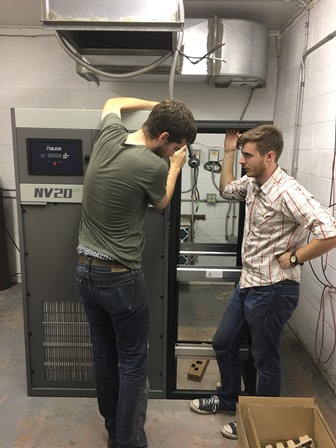New Delmarva Public Radio Transmitters Increase Sound Quality, Reliability
Tuesday November 8, 2016
 |
| Workers from Public Media Engineering installed Delmarva Public Radio’s new transmitters near Seaford and Roxana, DE. |
To DPR General Manager Dana Whitehair, however, they look like the future.
Replacing the stations’ 30-year-old transmitters — one still using vacuum tube technology and the other a prototype model (serial No. 00001) — is the latest step in upgrading DPR’s broadcasting equipment — and, along with it, sound quality and reliability.
“The beauty of an FM transmitter may not mean a lot to people who are not into these things, but to me, they’re gorgeous,” said Whitehair, a former chief radio engineer. “I’ve already had people say, ‘I’m getting WSDL or WSCL for the first time!’”
The Salisbury University-owned public radio stations, at 90.7 FM and 89.5 FM, respectively, send news and music — from an eclectic blend of adult album alternative and specialty programs on WSDL to classical and jazz on WSCL — throughout the Delmarva Peninsula. Following the stations’ move from main campus to SU’s East Campus Complex, however, their quality lagged.
This was, in part, because the relocation of the stations’ microwave tower — which sends signals from SU to the DPR transmitter sites — was delayed, Whitehair said. Until the tower was moved earlier this year, DPR transmitted its signal over the internet — a less-than-ideal situation, he said.
Problems with the delivery caused the stations to go off-air sporadically and unexpectedly — and some of their audience to tune out or seek alternative stations.
“Technically, we crashed,” Whitehair said. “But we’re back now, stronger than ever, and we hope our listeners will come home.”
Those who do may find things changed a bit. Whitehair is excited that the new transmitters — coupled with the tower relocation — will allow the stations to reintroduce shows that debuted during the internet-delivery days. These include Saturday evening jazz on WSCL, as well as WSDL programming such as:
• The Grateful Dead Hour. Hosted by David Gans, this popular show features exclusive interviews with, music inspired by and previously unreleased recordings from the Grateful Dead.
• UbiquiAmericana. Host Billy Earl takes listeners on a musical journey across the U.S. with a weekly sampling of selections spanning from bluegrass, folk, country and standards to jazz, rock and blues.
• UnderCurrents. The afternoon version of this nighttime staple features adult album alternative favorites with host Gregg McVicar.
• The Show About…. Produced locally by Chris Ranck, DPR program and operations director, who also serves as host, this “mixtape” show delves into music surrounding a new topic each week.
Whitehair also is enthusiastic about expanding broadcasts of locally recorded concerts on WSDL, from SU classical music ensembles, to bluegrass, to rock shows taped at Headquarters Live in downtown Salisbury, as well as performances of all types from throughout the Delmarva Peninsula.
At 20,000 watts, the new transmitters allow room for expansion should DPR be presented with an opportunity to increase its power and coverage area. It’s quite a change from the 10,000-watt transmitter formerly used for WSDL, which had a habit of “going through power amplifiers like candy — at about $1,250 each,” said Whitehair.
The WSCL transmitter required an electric fan blowing on it 24 hours a day to keep the same thing from happening. The new equipment is expected to save the stations money in both electricity and replacement parts.
Whitehair, however, was quick to add that doesn’t mean DPR doesn’t still need support from its listeners. Underwriters and campaign donations help keep the stations running, paying for programming, staff salaries and more.
“With technical reliability comes the increase responsibility to be the best public radio service on the peninsula,” he said. “We simply cannot achieve that without the generous support of our listeners.”
While the new transmitters have been in place just a few weeks, he said listeners noticed the difference in audio quality, clarity and fidelity almost immediately. Thanks to the increased capability of the equipment, all broadcasts are now digital. For Whitehair, “transformative” isn’t a strong enough word.
“It’s like a phoenix rising from the ashes,” he said. “We’re one step away from having completely replaced the entire audio chain from 2013 [when Whitehair became general manager]. The difference is incredible.”
He hopes listeners — the ones who have stuck with the station during its years-long technical difficulties, as well as returning audience members and those tuning in for the first time to hear what all the talk is about — agree.
For more information, or to support DPR, call 410-543-6895 or visit the DPR website at www.delmarvapublicradio.net.
